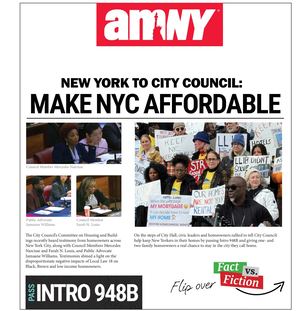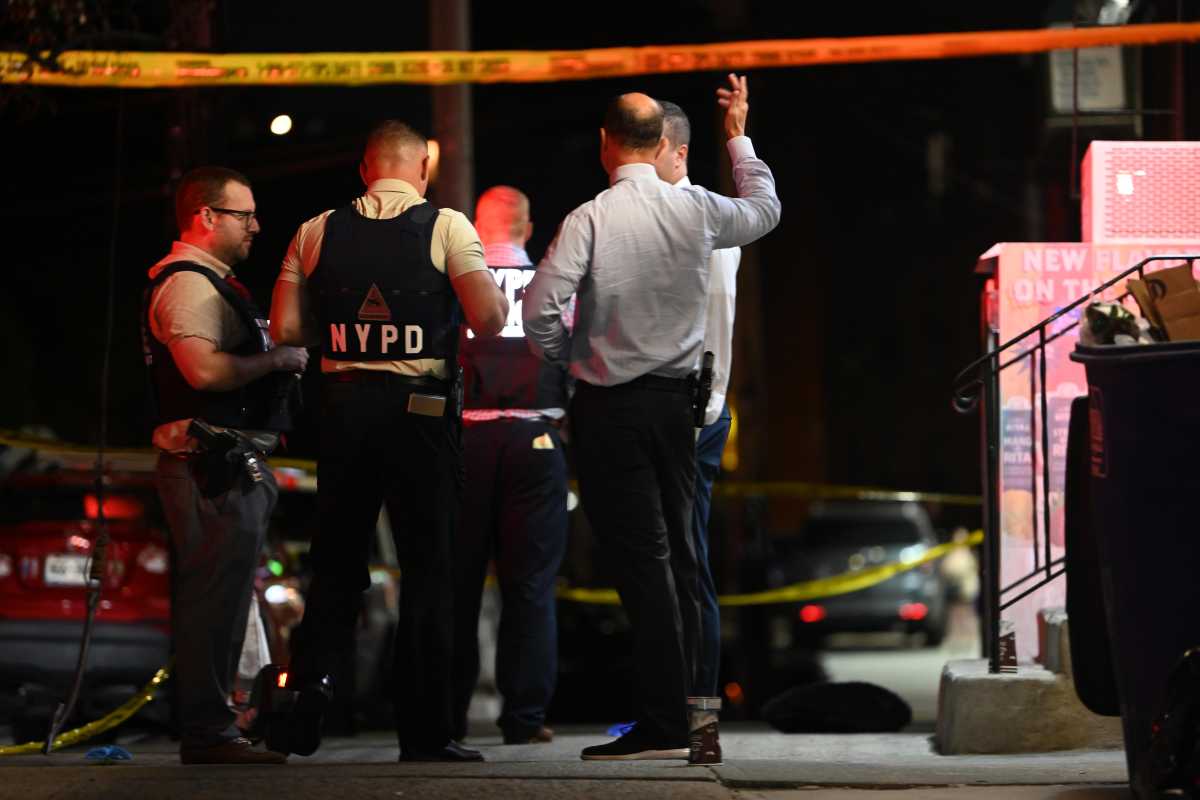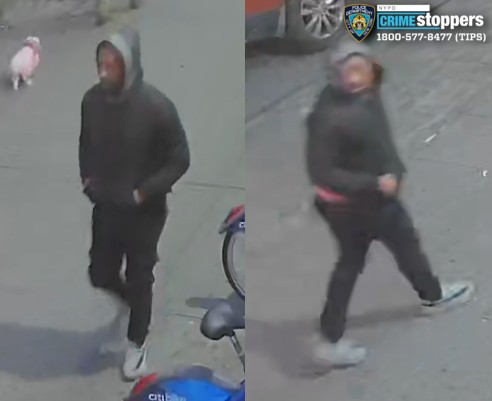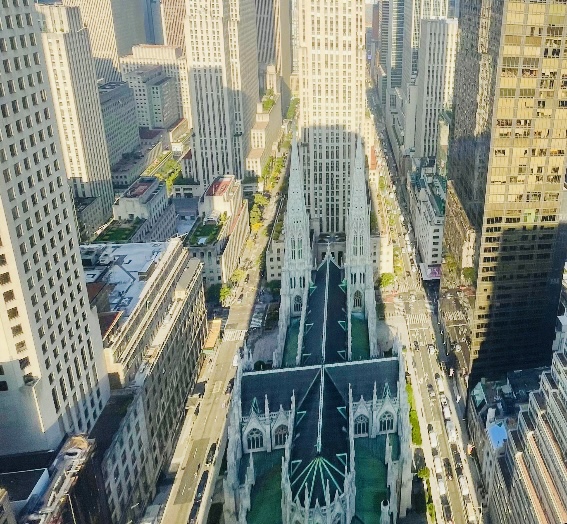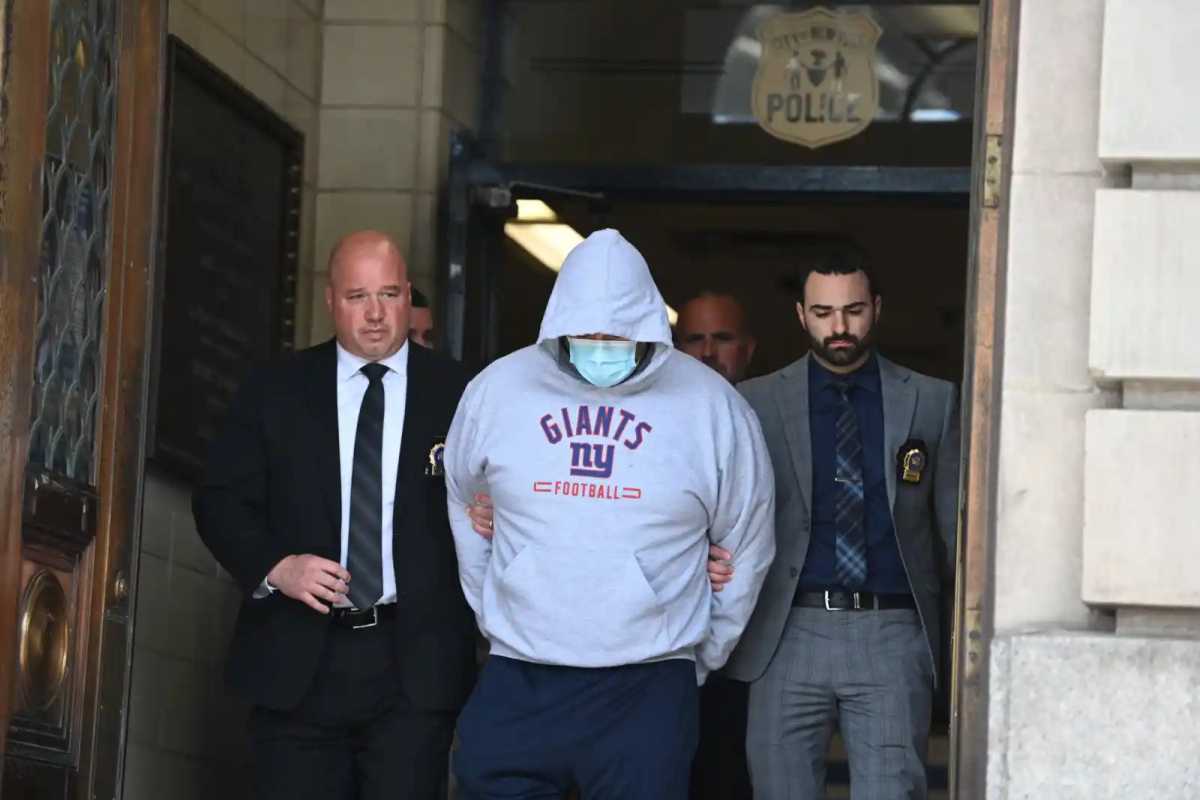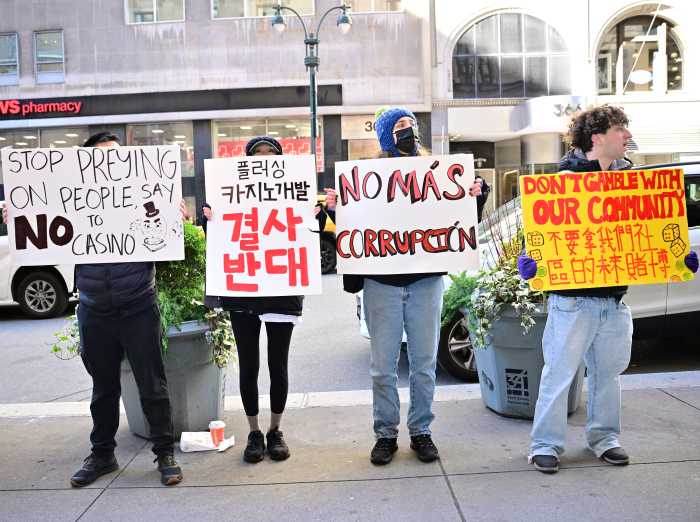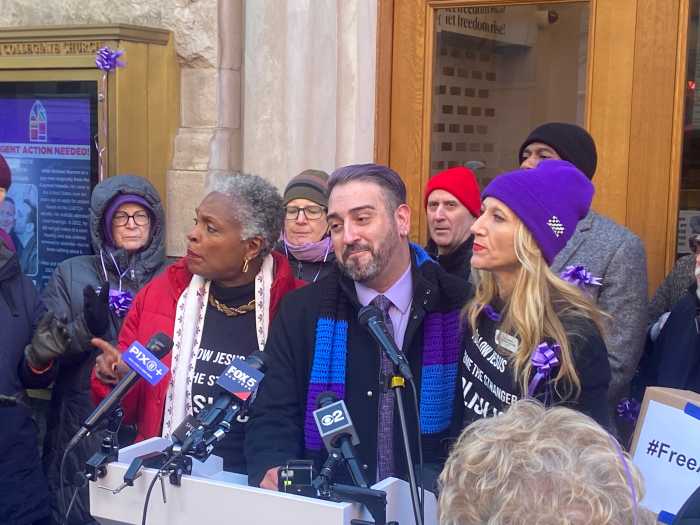By LINCOLN ANDERSON | Capping its five-year-long review of the redevelopment of the former St. Vincent’s Hospital site, Community Board 2 (CB2) issued a lengthy resolution, recommending that the zoning changes Rudin Management seeks for the project be denied unless the developer adequately addresses numerous points the board has flagged in nine areas of community concern.
In its 13-page-long resolution, the board stated its advisory opinion that there should be no allowed increase in development rights for the site; that the project should include affordable housing; that Rudin should “provide actual financial support” for new public school seats in the area, that an underground parking garage be eliminated from the plan; that construction impacts on neighboring residents and PS 41 be mitigated, and that there be no retail windows along the side streets on West 11th and 12th Streets.
The resolution was adopted by the 50-member board by a nearly unanimous vote.
Rudin is applying to the city for zoning map amendments, zoning text amendments and special permits to allow it to develop a 450-unit, market-rate, residential condo building on the site of the former hospital’s east campus — on the east side of Seventh Avenue between West 11th and 12th Streets.
The condos’ expected sale prices would reportedly range from $1.2 million all the way up to $29 million — only affordable for the so-called “1 percent” in Occupy Wall Street parlance.
Board 2’s resolution is the first step in the roughly seven-month-long uniform land use review procedure, or ULURP, for the project. The day after the board’s vote, its recommendations were sent to the Department of City Planning and local elected officials. The next step in ULURP is for Borough President Scott Stringer to weigh in on the applications, after which they go on to City Planning, then to the City Council for a final vote.
Several of the former St. Vincent’s buildings would be saved and retrofitted residentially for the project, while others — like the relatively new Cronin, at the corner of Seventh Avenue and 11th Street — would be razed and replaced with luxury apartments.
Specifically, Rudin wants to change the site’s current commercial zoning within 100 feet of Seventh Avenue from C2-6 to C6-2. That would increase the allowable developable floor area ratio (FAR) for residential from 3.44 to 6.02 while maintaining the current FAR of 6.5 for community facilities (which is what the former hospital was). Under the Rudin plan, the midblocks portion of the site would also be upzoned for residential use, from an FAR of 2.43 to, again, 6.02.
In addition, Rudin seeks a reduction of the amount of open space it would have to include in its development on the east side of Seventh Avenue — from 59,900 down to 29,900 square feet. Plus, a zoning change would be needed so that Rudin could count toward that amount 15,100 square feet in the open triangle at Greenwich and Seventh Avenues on the avenue’s west side — also part of the former St. Vincent’s property acquired by Rudin.
The third parcel of the former St. Vincent’s hospital site — the O’Toole Building, between 12th and 13th Streets on the avenue’s west side — is being gut-rehabbed and redeveloped as a Center for Comprehensive Care and 24/7, free-standing emergency department, the first of its kind in New York City. To be operated by North Shore-Long Island Jewish Health System, this project is “as of right,” meaning no zoning changes are needed. The facility would only have two short-term-stay beds, and patients needing admittance would be transported to local area hospitals.
Hard hats back Rudin
Last Thursday’s CB2 full board meeting was packed. Members of the Coalition for a New Village Hospital — who have been fighting for a full-service replacement hospital at the St. Vincent’s site — once again turned out. But they were outnumbered by about 30 members of the carpenters union, sporting bright blue T-shirts, who came to support the Rudin project and the 1,200 construction jobs it would provide.
An official representing another local — the laborers union — stressed, “The Rudin project is funded.” Meanwhile, he added, he’s seen many other projects fall through, and called the hope for a new full-service hospital “just a pipe dream.”
AIDS memorial plan
In addition, swelling the meeting’s numbers, 35 people turned out to testify in support of making the open-space triangle into an AIDS memorial. Members of the Queer History Alliance, they said they also want to make the underground space below the triangle into a learning center on AIDS. St. Vincent’s and the Village were “the epicenter” of the AIDS crisis in the 1980s, speakers said, and the memorial would ensure that future generations don’t forget.
Andrew Berman, executive director of the Greenwich Village Society for Historic Preservation, said of the Rudin residential project, “No matter what way you cut it, upzoning is being proposed. I think that’s wrong for this community and wrong for the city.” Making matters worse, he said, the upzoning would be done for “a private, for-profit developer.”
However, Melanie Meyers, a land-use attorney for Rudin, asserted, “There will be no development rights added to the site.” Rudin argues this is the case because most of the buildings on the site are grandfathered to allow their residential conversion.
Shino Tanikawa, a PS 41 parent and school activist, told the meeting she was speaking as a member of the Live and Learn Coalition. The new group has been pushing for Rudin to do more to relieve school overcrowding by helping fund the acquisition of the state-owned building at 75 Morton Street. Rudin did provide a financial guarantee so that the city could buy space in the Foundling Hospital building, at 17th Street and Sixth Avenue, for a new 564-seat school — but Tanikawa said that’s not enough, and appealed to Rudin for a bigger commitment by helping on 75 Morton Street.
‘Help us get that building’
“Yes, the Foundling school is going to come online,” Tanikawa said, “but it will be full the day it opens. Please — help us get that building.”
Village resident Judge Joan Kenney voiced concern about the impact that demolition and construction from the three-year project would have on students at nearby PS 41. The elementary school lacks air conditioning to filter the air, so its windows will stay open, potentially exposing the youngsters to harmful particulates, like asbestos, she said.
“When those buildings come down, there has to be a safety plan,” she stated.
Before they voted, CB2 members first debated the resolution among themselves. Arthur Schwartz proposed adding a “friendly amendment” right at the beginning of the resolution, saying that the St. Vincent’s site should be used for a hospital.
“There are still people fighting for a hospital,” he pointed out. He made a passing reference to the idea of a “land lock” — a made-up term that does not exist in the city’s zoning regulations. Members of the Coalition for a New Village Hospital had coined the term, saying they didn’t want the St. Vincent’s site’s zoning to be changed from hospital use. However, the site’s current zoning, in fact, allows both residential and hospital use.
Schools vs. hospital?
Schwartz further criticized the resolution, saying that while it didn’t sufficiently prioritize a hospital, it instead had a section devoted to urging Rudin to pony up money for public schools.
“You shouldn’t be pitting the need of the community for schools against the need of the community for healthcare,” he said.
Jo Hamilton, CB2’s immediate past chairperson, promptly rebutted Schwartz, saying, “No one has come forward in the year and a half that St. Vincent’s has been closed. There’s been no credible proposal [for a hospital]. How many times have we said that?”
Keen Berger, chairperson of the board’s Social Services and Education Committee — looking a bit annoyed at Schwartz’s last-minute critique — added that the board’s saying it wants more schools doesn’t mean it favors an upzoning on the St. Vincent’s site.
David Reck, chairperson of the board’s Land-Use and Business Development Committee, bluntly stated, “I’m sorry to say, we are faced with a real-world, land-use application. If we want to have a say, we have to get real.
“The worst thing would be for that site to remain vacant,” Reck said. “I think we have to face up to the fact that we’re not getting a hospital.”
After the meeting, hospital activists Jim Fouratt and Gerrie Nussdorf slammed the board’s resolution as a “bait and switch,” charging it was “divide and conquer” and pitting “children versus a hospital.”
“I’m very worried about the zoning,” Fouratt said. “And secondary to that, I’m not opposed to schools or affordable housing,” he said, though then added, “I think it’s really sad that these unsalaried community board members let themselves be swayed by money and power and children’s need.”
‘Not a bait and switch’
However, in her remarks before the vote, board member Lois Rakoff said the criticism was unwarranted.
“I’m an advocate of a full-service hospital, Level 1 trauma center,” she said. “But this is not a bait and switch, and it’s not going to be a deal.”
David Gruber, though, stated, “The applicant shouldn’t be required to provide money for a school — that sounds like horse trading.”
‘Board was fair, forceful’
Brad Hoylman, CB2’s chairperson, later dismissed accusations that the resolution was conceivably designed to drive a wedge between interest groups.
“The community board has the obligation to set forth in its resolution all of the priorities we’ve heard during the ULURP process.” he said. “I think we’ve done that fairly and forcefully. I don’t see a conflict between healthcare and new schools, affordable housing, open space or any of the other priorities that the community board has set forth. These are all important public goods that complement each other. I don’t buy it that somebody who wants a new school or affordable housing is in opposition to someone else who wants a new hospital. We need to fight hard on all fronts for these things for our community.”
Hoylman added that the way the board’s resolution is worded, it recommends keeping open the possibility of adding floors on top of the O’Toole Building to create more hospital beds or perhaps a hospital in the future.
Occupy St. Vincent’s!
Yetta Kurland, a leading member of the Coalition for a New Village Hospital, was at the meeting earlier, but wasn’t around by the time the board voted on the resolution. A coalition member said Kurland had to go do a radio show that night. However, Kurland did leave a note saying the coalition would join with Occupy Wall Street to “occupy St. Vincent’s” at the former hospital on Wednesday, October 26.
AIDS memorial issues
Regarding an AIDS memorial at the triangle site, the matter will go before CB2’s Parks Committee next month. Although the community board hasn’t passed a resolution on the proposal yet, there was an initial presentation to the committee last month. According to the committee’s written report, during the presentation there was some “concern…raised regarding the impact on the park and possible creation of a regional destination.”
Tobi Bergman, the Parks Committee’s chairperson, later said, “I’m not sure there’s a meeting point in what the community wants in terms of a park and what they [Queer History Alliance] want as a memorial. I hope there is a meeting point.”
Hoylman said of the AIDS memorial pitch, “It is a compelling idea that unquestionably has broad support behind it. We’ll continue to work with the Queer History Alliance because we think their involvement could help us secure a better public space.
“It’s true that the park could become a destination for tourists, so we need to ensure that the park maintains a local character and feel,” Hoylman added. “There are other ideas, too, for different memorials or tributes in the park and these have to be considered. There is a lot more work to be done on the park, so we hope the local community will come to a public workshop in early November that the community board will be hosting.”
John Gilbert, COO of Rudin Management, said, “The Rudins are fully committed to working with the community to determine an appropriate design for the park. We have received a lot of good feedback through the community review process and are studying many ideas of how to memorialize the memory and history of St. Vincent’s, the Sisters of Charity — who founded the hospital in 1849 — and the institution’s role in serving people impacted by HIV/AIDS, 9/11, the Triangle Shirtwaist tragedy and the survivors of the Titanic. The CB2 resolution has given us direction and we will continue to keep an open ear to their wishes.”
CB2 in its ULURP resolution stressed that the triangle should eventually be given over to the Parks Department, and should have “a very low fence with gates that are locked at night.”
The board also stated that the triangle’s underground basement space might have to go if it prevents the planting of large trees in the park above.
More points on plan
Among other recommendations on the ULURP application, CB2 said it was disappointed that North Shore-L.I.J. has declined to upgrade the 12th Street and Seventh Avenue subway stop with an elevator/escalator, especially since many of the planned health facility’s clients will arrive by mass transit.
The board also advocated for preserving and reusing the former St. Vincent’s Reiss Building instead of demolishing it as part of the Rudin project. However, the city’s Landmarks Preservation Commission has approved razing Reiss.
In addition, the board said no new underground garage is needed on 12th Street since the block already has three and the neighborhood offers ample on-street parking.
